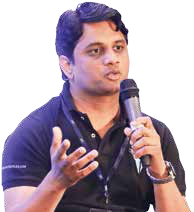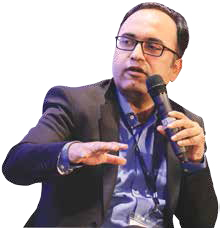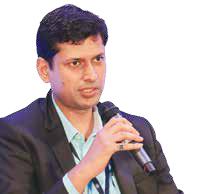Founders from various leading technology companies had a riveting discussion on India-centric technology innovations at 16th CII Manufacturing Summit, which was held recently at Mumbai. The panellists at the session exchanged views and ideas on—Is industry 4.0 being implemented across the value chain, and the how important it is for the policymakers in supporting the industry by setting up prototype centres in each state of the country?
The Panellists: Session Moderator Govind Raj Ethiraj, Founder, Ping Digital Broadcast; Dhananjay Pande, CMD, Gurlife Agro-Tech LLP; Jashish Kambli, Executive Partner, Future Factory; Rahul Garg, Founder & CEO, Moglix; Kapil Shelke, Director, Tork Motorcycle and Vikas Banga, Associate Director, BCG India

Rahul Garg: I am a founder of a company called Moglix. Moglix was started in April 2015 and was formed for one mission—can we re-imagine B2B commerce with technology?
I have worked for five years with Google before starting this venture. However, I realised that the use of technology today, which is used in some of the traditional verticals is very less. We are solving the challenges associated with manufacturing organisations. We have worked with two sets of manufacturing organisations. First set consists of manufacturing organisations whose annual turnover was about 100 crore and who were classified as SMEs. Second set consists of manufacturing organisations which may have turnover from 100 crore to 60,000 crore. In each of these organisations, we have realised that the fundamental digitalisation of processes is broken.
We have continuously strived over the last two and a half years bringing in the best-in-breed technology that is happening in manufacturing world, non-manufacturing world, consumer world and financial world.
To summarise, digitise everything. Firstly, if you are operating any part of your business manually, we think it is not right. Secondly, this is the crucial time in India because of GST, you can rethink what you do on a domestic manufacturing basis, what you want to do in export, what you want to do in import.

Dhananjay Pande: We are an environmental research organisation and we have developed several carbon dioxide reduction technologies, which reduce air pollution. While we were discussing these technologies with the clean technology head in a meeting, they said that they had received an order from National Green Tribunal (NGT) of closure of jaggery manufacturing units in Uttar Pradesh, because the jaggery manufacturing units contributed 33% of air pollution. The topic of discussion was how our carbon dioxide reduction technology can be implemented and how the government can help us. They asked whether we could help them in implementing carbon dioxide reduction technology in jaggery manufacturing units in order to reduce air pollution. While analysing this area, we realised that this is the most neglected sector—jaggery manufacturing. The conditions are very tragic, technology is outdated, there are hazardous and unhygienic manufacturing processes. Ninety per cent of jaggery manufactured in India is about 30 million tons, which is manufactured by unorganised sectors. This situation needs to be improved upon from every angle so we suggested MoU that probably you have to design the entire manufacturing process, right from the crushing devices. However, MoU funded us. We have now completely redesigned the entire manufacturing process. The final design was related to the carbon dioxide reduction, which is about the gas that goes out from the chimney. Since we can capture the carbon dioxide, the problem is what you do with the captured carbon dioxide and how do you make by-products of captured carbon dioxide. So we thought it would be helpful for farmers if we are able to come out with a by-product which will help them. Ours is the first plant where we have improvised the working of jaggery manufacturing plants in India, where carbon dioxide is converted into biopesticide.
“We have developed a reactor, which gets charged with the waste from plants. Also, we are going to try the same with solar energy. Energy can be stored; energy can be transferred without electricity”
—Dhananjay Pande

Jashish Kambli: I work for Future Factory, where I head design and development department. There are a couple of things we do at Future Factory. First, we help our manufacturing companies to be customer-centric. What we have found and what is prevalent today is that most manufacturing companies believe in getting a good technology product in the market but they forget what exactly the customer is looking for. So we did two things, make companies understand their customers better, and make entire offers more customer-centric. The second thing we do at Future Factory is we help in innovation.
We work on security division of Godrej. Back in 2013, we had penetration in the market by one per cent. We are not a very safe society, so why security products are not selling as much as they should be? We went to understand the problem as to why people are averse to security products and in return understood the Indian psyche. We want to believe that the government will take care of us. For example, we did some research during the Karva Chauth festival, in the North. We went to their homes, we asked the women, “Where do keep your jewellery?” They replied, “It is with my mother-in-law. My motherin- law stays just two buildings away”. We asked, “Why is the jewellery with her?” They said, “I cannot take the responsibility”. Mother-in-law is a 65-year-old single woman; she is dumped with the responsibility to take care of jewellery.
Jashish: We drew a graph in terms of convenience vs. the security and found that we, as a company, were producing more and more secure safes, which puts the onus on the person who bought that safe. We get security for a certain level of convenience and we played with that idea, so we have a wide range of products and one of those products, that we have designed is called Goldilocks. We launched Goldilocks about two years ago and it is a small safe, which is very easy to use. It supplements digital technology with electronic security and it is meant for more everyday things and allows people who don’t want to interact or who have never interacted psychologically with security products.
“What we have found and what is prevalent today is that most manufacturing companies believe in getting a good technology product in the market but they forget what exactly the customer is looking for”
—Jashish Kambli

Kapil Shelke: I founded a motorcycle company called Tork Motorcycles. I started working on it in 2007. Earlier, I used to build electric motorcycles for racing. I didn’t have any validation platform in India, so we went to a country called Isle of Man where some of the world’s famous motorcycle racing events are held. We were the only Indians to participate in such a race and to win the podium. I kept on participating in electric motorcycle championship for 3-4 years. I worked with a Chinese startup as a CTO, coming back to India, this time, I thought somebody in India will manufacture. I didn’t see anyone manufacture it so I thought I should manufacture such bikes.
From 2015 onwards, we started as Tork Motorcycles. We are building India’s first electric motorcycle, with a top speed of 100km/hr, which will can run 100 kilometres on a single charge and which takes about one hour to charge or about 30 minutes with fast chargers.
“We are building India’s first electric motorcycle, with a top speed of 100km/ hr, which will can run 100 kilometres on a single charge and which takes about one hour to charge or about 30 minutes with fast chargers”
—Kapil Shelke
Yes, we will be launching next year. In terms of scale, we will find the cities who will adapt electric vehicles faster. We announced this motorcycle last year and there are thousands of people who have booked saying that we are going to buy it. They come from Pune, Ahmedabad, Bengaluru, and Chennai and we will launch in these cities. We think about 5,000 motorcycles will be sold in the first year and by then we will get to know about our customer base and how they will be using it. We want to get to other cities and the idea is to focus on cities where people are ready to go for.
The promotional price is Rs.1.25 lakh. Think of it as a motorcycle with a tablet on it. It will navigate to your office, it can charge in one hour and will let you know who is calling you.

No, we are not making the battery but the battery box. India still does not have efficient lithium-ion battery manufacturing setup.
Vikas Banga: I have worked with BCG as a director. BCG is helping industries in India and Asia-Pacific. Nowadays everybody says we should be digital but what we try to do is helping them by reimagining or rethinking the fundamentals of manufacturing that are happening right now in your companies. Be it sales, be it manufacturing, engineering or R&D or be it supply chain or logistics. For example, we are working with the leading steel manufacturers in India. We help them to re-optimise their shipping algorithms and logistics. Since steel is the raw material, transportation is a big cost; due to optimised shipping algorithms and logistics, yuo can save on transportation. Another example is, helping the leading auto manufacturer to rethink how the car should sell in India in future. We actually implement in today’s world where Indian customer is shifting from offline to online buying.
“There are model factories being setup in universities in Germany, where a manufacturer can get a taste of how the segment of one manufacturing is possible, or how can I use the same line to make a washing machine as well as an electric motorcycle”
—Vikas Banga

Rahul: I think there are two aspects to it. One aspect is sectorial aspect, which means how the technology has penetrated the advertising industry, financial exchanges, banks and all of those types of industries. There are lot of discussions happening regarding the industry 4.0 and how should India prepare to compete globally. If you consider manufacturing sector, it has remained aloof in terms of digitising each of its functions.
In manufacturing organisations, you have data sitting around about your supply chain, your customers, your logistics service provider and machine efficiency. How are you going to work on each of these data? If you don’t have digital way of looking at this data, then you cannot unlock the value of this data. So it is very critical that as a sector, if you want to become efficient, if you want to compete in the global economy, you should digitise your functions.
On the other hand, US is looking at automation, robotics and artificial intelligence and people in India are saying, ‘should I do this work manually or should I do it the digitally’. People say that this has been my way of doing things for the last 40 years and who are you with no manufacturing background per se to talk about digital and or how I should run my business. What we want to say to them is let us come and present you what are the opportunities you are missing out, because, everyone wants to grow your business. If digital is going to enable you to do this, then there is no reason you should shy away from digitisation. Earlier, maybe you did not have access to people who can talk digital and manufacturing together in the same sentence but there is a growing breed of startups like us.
The second aspect is about geopolitical conversations, conversations about protectiveness and industry 4.0. In my view, it boils down to simply three things. One is how you digitise and continuously strive for better efficiency. Secondly, there is a coming together of a virtual world and a physical world. The third thing is how you reach that stage where physical product being developed is also going to be continuously automated. It would use more data orientation towards achieving that objective. And that’s the key thing and I think the timing is perfect for India, because there is enough political push around it, enough policy changes that are around it. The next 10 years can redefine whether India can be a relevant manufacturing nation, in a global context and not in domestic context.
“If you are operating any part of your business manually, we think it is not right. And this is the crucial time in India because of GST, you can rethink what you do on a domestic manufacturing basis, what you want to do in export, what you want to do in import”
—Rahul Garg
Rahul: I think it is coming together of all, because if you are constrained because of certain export and bilateral policies, yes, you need to unlock that. Fundamentally, my question is, are you preparing for what you can do on your side, about becoming efficient, ready for faster scale and for faster product development with the best quality of supply chain? Supply chain is very important, both on your distribution and procurement side, because that is what makes it efficient, in terms of discovering customers, in terms of discovering markets and efficient products for you, which will make you make a cost competitor, like the example Kapil talked about lithium-ion batteries which he is importing from China. We all always say that government is doing this and that and that’s why I am not doing this. That’s a very lazy approach.
Dhananjay, we talk about India-centric innovations, when we solve a problem. In your case, the jaggery industry was disrupted by an NGT order due to which the disorganised sector was thrown out and somehow you saw an opportunity. That is one kind of opportunity. If you look at opportunities, which are going to be in India, which are India-centric, or we actually could be creating something global to solve a global problem?
Dhananjay: We have developed a reactor, which gets charged with the waste from plants; also, we are going to try the same with solar energy. Energy can be stored; energy can be transferred without electricity so that’s what the point is. It will have an application especially in the rural areas where farmers don’t have the cold storage facilities, and government cannot provide such facilities.
Jashish: I think many of our innovations in India come from bottom-up, from practical problems like lack of infrastructure. Having said that when you actually develop something, which can go great. For example, energy is a problem throughout the world. Some people might have a lot of it and some people can’t have enough of it, is a problem. Taking these innovations to countries abroad, is not about the innovation, it is about the infrastructure which enables us to get there, it is about the quality, it is about the design, it is about the idea, it is about being able to protect and patent this and that is why as a country we suffer. We don’t seem to have global aspirations, I think one thing we can do as a manufacturing sector, as India, is to have aspirations of the globe, we tend to satisfy with being happy with what we have, we tell ourselves we have 1.3 billion people and that is a good enough market.
Vikas: Let us take industry 4.0. There are model factories being set up in universities in Germany, where a manufacturer can get a taste of how the segment of one manufacturing is possible, or how can I use the same line to make a washing machine as well as an electric motorcycle. There are examples out there for manufacturers to go and see. Do we have something in India? No, maybe it is time for us to create something like that with the help of our government. Well, at the same time, you cannot copy and paste what is happening in the West, and use the same robot, that was working well in Germany, and bring it to India and hope that it will give you the efficiency, which you need. The processes, which one needs, are to be customised.
By Vineet Kapshikar